| Benjamin Davis |

| ||
|---|---|---|---|
| Home Page | Airmen Index | ||
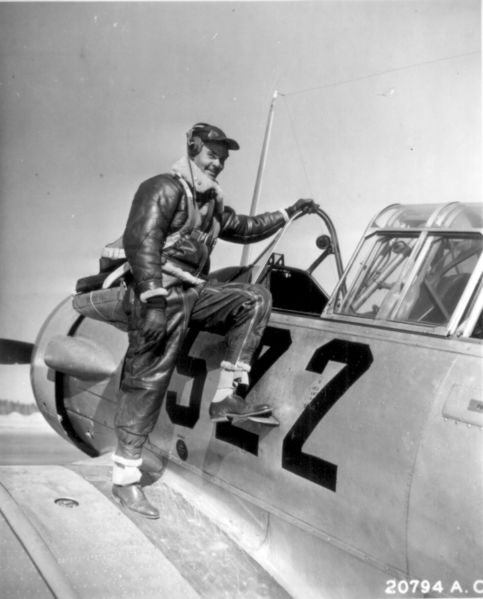 |
|||
|
Barred initially from flight training because of color, the leader of the Tuskegee Airmen became a major force for full integration in the Air Force. | |||
|
Benjamin O. Davis, Jr., was born December 18, 1912, in Washington, D. C. His father, Benjamin O. Davis, Sr., was one of two black combat officers in the US Army. Davis Senior's career was badly stunted by segregation. He opposed the practice as not only harmful to black soldiers, but also wasteful to the country. Young Ben Davis grew up inside his father's profession. From the beginning, he despised segregation and was determined to destroy it.
In a way, he did—performing so well and leading so effectively that the arguments used to prop up segregation in the Air Force were fatally undermined. He became the first African-American Air Force officer to achieve general's rank, retiring as a lieutenant general in 1970. |
|
In 1991, he published his autobiography, and much about the man could be discerned in its simple title Benjamin O. Davis, Jr., American: An Autobiography.
The younger Davis wanted to fly. To fulfill that ambition, he set his sights on the US Military Academy. He earned an appointment in 1932 from Rep. Oscar S. De Priest (R-IL.), the only black Congressman at that time. Davis believed his classmates would accept him based on the content of his character and not reject him because of his race. He was wrong about that. For four years he was shunned, meaning other cadets would only speak to him for official reasons. He had no roommate and took his meals in silence. Those who caused this had hoped to drive Davis from the Academy, but their actions only made him more determined to succeed. He graduated thirty-fifth out of 276 in the Class of 1936. Davis was sure that he would be given the opportunity to fly because he was academically and physically qualified, but it was not to be—not then, anyway. He was turned down for flight training because there were no black units in the air service, and herefore he could not be accepted, despite his qualifications. Segregation was the barrier.
Davis's first assignment was to Ft. Benning, Ga., where he commanded the black service company. After a year, he was appointed to the Infantry School. In the two years Davis served at Benning, the nine Academy classmates also assigned there only talked to him in the line of duty. When Davis graduated from the Infantry School, he was qualified to be in an infantry unit but instead was sent to be a Reserve officers Training Corps instructor at Tuskegee Institute, Alabama, replacing a sergeant. |
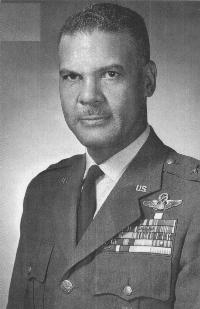 |
Davis, in his P-51B, led many World War II missions, including a memorable 1,600-mile bomber escort to Berlin on March 24, 1945. In 1953 he became the first African-American Air Force officer to achieve general's rank. (Photo - Benjamin Davis) |
|
Davis was serving at Tuskegee in 1940 during the second reelection campaign of President Franklin D. Roosevelt. Roosevelt, determined to hold on to every group that had supported him in his two previous election victories, was especially worried about the black vote. To solidify his African-American support, he promoted the elder Benjamin Davis to brigadier general and ordered the Army Air Corps to create a black flying organization.
The Air Corps wanted a black Academy graduate to command the first unit. The younger Davis was the only living black West Point graduate and was ordered to begin training at Tuskegee AAF, Alabama. He clearly saw an opportunity to undermine segregation. On March 7, 1942, Davis pinned on the silver wings of Army Air Forces pilots along with four other black officers. In time, they were joined by almost 1,000 Tuskegee Airmen. In the spring of 1943, Davis and the 99th Fighter Squadron (first established as the 99th Pursuit Squadron) departed for North Africa to join the fight against the Axis. The Tuskegee Airmen carried with them the usual burdens borne by men about to enter combat but also the certain knowledge that upon their inexperienced shoulders rested the future of black Americans in aviation. The 99th was attached for operations to the 33d Fighter Group in Tunisia. on June 2, 1943, the 99th, led by Davis, flew its first mission, attacking troops on Pantelleria island, an enemy position between North Africa and Sicily. About 90 days later, after the squadron had flown many combat missions under Davis's leadership, the 33d Group commander accused the Tuskegee Airmen of not having the same desire to fight as white pilots. He recommended removing the Tuskegee Airmen from combat. The general who reviewed the report endorsed it and commented that "the Negro type has not the proper reflexes to make a first-class fighter pilot." |
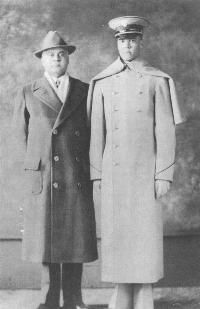 |
Father and Son: West Point Cadet Davis, shown here with his father, Benjamin O. Davis, Sr., graduated near the top of the Academy Class of 1936, after four years of shunning by classmates. The career of the elder Davis had been stunted by segregation, an evil the son was determined to destroy. (Photo - Benjamin Davis) |
| Marshall's Wisdom |
|---|
|
By the time this proposal surfaced in Washington, other black flying organizations were being created, among them the 332d Fighter Group and the 477th Bombardment Group (Medium). However, Gen. George C. Marshall, the Chief of Staff of the Army, decided to study the issue, assigning review of the 99th to the War Department's permanent Advisory Committee on Negro Troop Policies. The committee, led by John J. McCloy, called on Davis to testify.
Davis said that on June 9, 1943, during one of its first missions, the 99th formation disintegrated when it was struck by a German fighter force twice its size. The Germans surprised the Americans by attacking from above and out of the sun. Nobody, Davis argued, could cite another example of a Tuskegee Airmen formation crumbling, and in this single case, the men did not flee the battle but fought it out man-to-man against superior German aircraft. Davis maintained, moreover, that his men were as eager for combat as white pilots, flying more often because his squadron was undermanned and replacements were short. Sometimes his men flew six combat missions per day, more than white pilots. Davis's testimony carried the day. The Advisory Committee recommended—and Marshall agreed—that the 99th should not be pulled from combat, the 332d Fighter Group should move overseas when trained, and the 477th Bombardment Group should be formed. It was a wise decision—in the next 18 months, the Tuskegee Airmen wrote an impressive record. In January 1944, the 332d, equipped with P-39 Airacobras, began arriving in southern Italy. At the same time, the 99th, now commanded by Maj. George S. "Spanky" Roberts, was flying missions in support of the Anzio landings. On the morning of January 27, 15 Tuskegee Airmen Curtiss P-40s met a larger number of German Fw-190 fighters, shooting down six and damaging four others—a remarkable performance considering the mismatch in aircraft. That afternoon, the Tuskegee Airmen shot down three more Germans. on January 28, the black American pilots destroyed four German aircraft, and between February 5 and February 10, another four airplanes were downed by the Tuskegee Airmen. In that two-week stretch, the Tuskegee Airmen achieved a seven-to-one ratio of victories to losses . |
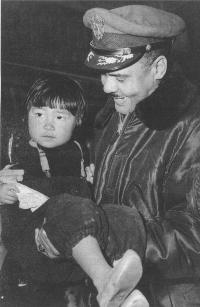 |
In the spring of 1953, USAF assigned Davis as commander of the 51st Fighter-Interceptor Wing, Suwon AB, South Korea. He thrived in this wartime assignment, supervising a wing of thousands of airmen, almost all of them white. (Photo - Benjamin Davis) |
|
A few months after arriving in the theater, Davis was assigned to the bomber-escort mission. He saw this change as a clear opportunity to demonstrate the capabilities of black aviators and to further undermine segregation .
In June, the 99th Fighter Squadron joined the 332d, now equipped with P-47s, and a month later the 332d was given the P-51. Davis led the first escort mission, protecting B-24s bombing targets around Munich. That day, 39 P-47s held off more than 100 German fighters. At one point, Davis personally led a flight of eight P-47s attacking 18 Bf-109s, scattering the Germans and shooting down several. During that mission the Tuskegee Airmen shot down five fighters and damaged another. |
| Spectacular |
|---|
|
Perhaps the most spectacular mission flown by the 332d was its mission on March 24, 1945, when Davis led the 332d on a 1,600-mile round trip escort mission to Berlin. on that day, the Tuskegee Airmen met numerous Fw-190s and at least 30 of the new German Me 262 jet aircraft. The Tuskegee Airmen shot down three of the jets and damaged another six fighters. one of the Tuskegee Airmen was lost on this mission, but none of the bombers were lost, despite the fact that the Germans threw their latest and fastest fighters at the Americans .
Prior to March 24, only two Me 262s had been shot down by any Allied airmen, and on that day the third, fourth, and fifth were destroyed by the Tuskegee Airmen. How good were they? Davis and his men had destroyed far more aircraft than they lost—shooting down 111 enemy aircraft and destroying 150 aircraft on the ground, while losing 66 aircraft to all causes in the US and combat zones. The Tuskegee Airmen had also shattered or disabled more than 600 boxcars and other rolling stock. They had sunk one destroyer (a unique achievement) and more than 40 other boats and barges . Most importantly, the Tuskegee Airmen had not lost a bomber to an enemy fighter during 200 escort missions, totaling about 10,000 sorties into some of the Third Reich's most heavily defended areas. It was a tribute to their skill and to Davis's leadership. He made the 332d a disciplined fighter group that knew they performed their escort missions as well as any in the entire Air Corps. |
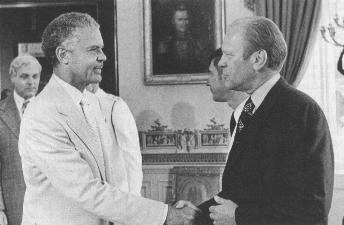 |
In 1970, Davis retired as a lieutenant general, having worn the uniform for some 33 years. He continued to work, serving in various roles, including assistant secretary of transportation for safety and consumer affairs. Here in 1974 he talks with President Gerald Ford. (Photo - Benjamin Davis) |
|
Davis returned to the US in April 1945, gaining command of the 477th Composite Group at Godman Field, Ky. He moved the 477th to Lockbourne AAB, Ohio, in 1946. He overcame local bigotry through his professionalism, and by the time the Air Force integrated in May 1949, his base had become a treasured part of the community.
In addition to commanding the flying unit at Lockbourne, Davis also served as base commander. Probably the most important aspect of his command was his relationship with whites on the base. Davis supported an Air National Guard fighter wing, a troop carrier squadron, and several other all-white Air Corps organizations, and the record shows only harmonious relations between the Tuskegee Airmen and their tenants. Equally important, almost all of the civil servants then working at Lockbourne were white and all of their supervisors were black. Nowhere else in America could one find this situation. For centuries people said whites would never work for blacks, but at Lockbourne several hundred whites worked professionally and well for Davis and the Tuskegee Airmen. Segregation was steadily undermined by Davis's performance, combined with the achievements of his 332d Fighter Group. When the Air Force separated from the Army in September 1947, Lt. Gen. Idwal H. Edwards, deputy chief of staff, personnel, directed a study of USAF racial segregation. He was aware of the unique success of the 332d (after 1947, the 332d Fighter Wing at Lockbourne AAB) during the war and its professional service after it. |
| The Big Step |
|---|
|
Edwards recommended racial integration and convinced the Chief of Staff that such a reform would mean a better Air Force. His principal argument was that Davis and the Tuskegee Airmen had proved in war and peace that blacks could perform all jobs as well as whites. That fact alone was enough to undermine segregation, and the Air Force in 1949, became the first of the US armed services to integrate racially.
In the summer of 1949, Davis attended the Air War College, a key assignment because promotion beyond colonel depended upon attending war college. Before Davis did so, no black officer in any service had ever attended war college—segregation had barred such attendance. Davis excelled, despite the fact that the Air War College was located on a base in Montgomery, Alabama, an area hostile to any African Americans who aspired to rise economically or professionally. The best restaurants, hotels, and housing in the city were closed to Davis and his wife, Aggie. He and Mrs. Davis could anger the bigots among Montgomery's whites just by driving a late-model automobile. Davis detested this treatment but tolerated it to graduate from the Air War College. Like many of the best in his class of 1950, Davis moved from the Air War College to the Pentagon, where he served at Headquarters USAF. Soon after arriving in Washington, Davis was made chief of the Air Defense Branch of Air Force operations, a prestigious position in which he supervised white officers and enlisted men. So successful was Davis in his Pentagon position that in 1953, while the Korean War was still raging, the Air Force assigned him to take command of the 51st Fighter-Interceptor Wing, Suwon AB, South Korea. Davis thrived in this assignment, supervising a wing of thousands of airmen, almost all white. The Air Force learned that white airmen and officers would work loyally for a black commander, and the wing was as effective as any other Air Force unit in Asia. Having again demonstrated his skills as a commander, Davis was transferred to Japan, where he was appointed director of operations and training in Far East Air Forces. Three months later, he was promoted to brigadier general, the first black officer in the Air Force to achieve that grade. Davis was soon reassigned to what proved to be his most significant postwar position—vice commander of 13th Air Force and commander of Air Task Force 13 (Provisional) at Taipei, Taiwan. He was to build a defensive air force from scratch, to deter Communist forces on mainland China from launching an air or sea attack on the Republic of China on Taiwan. In two years Davis built a formidable defensive air force. Davis next moved to 12th Air Force in Germany and later became the deputy chief of staff for operations for US Air Forces in Europe. He returned to the US in 1961 as a major general and as USAF director of manpower and organization. He served in the Pentagon for four years, earning a third star, and moved in April 1965 to Korea to become chief of staff of the United Nations Command and US Forces Korea. Davis succeeded in Korea and became commander of 13th Air Force in August 1967, taking command of more than 55,000 people all over Asia, including many thousands who were flying and fighting in the Vietnam War. Davis was responsible for the air defense of the Philippines as well. He held this post for a year. |
| Strike Command Days |
|
Davis then moved back to the US, where he was assigned as deputy commander in chief of US Strike Command. No other assignment for Davis had such worldwide implications as this assignment, and he traveled widely to see for himself the conditions under which his men and women might have to fight.
After two years as the deputy commander in chief, in 1970, he retired from the Air Force. He had served more than 33 years on active duty and had been all around the world. He had excelled in every position, and he left the Air Force and the military service a much better institution than he had found it. Davis was no longer in the Air Force, but his professional life was far from over. He became the director of public safety for Cleveland, Ohio, overseeing the city's fire and police departments. Later, Davis became director of civil aviation security and an assistant secretary at the US Department of Transportation. When Davis joined the Army Air Forces, he was the only black officer and when the service integrated in 1949, there were only 375 black officers in the service (about 0.6 percent of the total number of officers). Today, (1996) there are about 4,000 black officers in the Air Force, almost six percent of the total. Davis can claim the largest portion of the credit for opening the doors to black men and women. None of his achievements mean as much to him as his role in bringing about the integration of the US Air Force.
Col. Alan L. Gropman, USAF (Ret.), a department chairman at National Defense University, has published widely on the-topic of the Tuskegee Airmen and other subjects. His article for Air Force Magazine, "The Tuskegee Airmen," appeared in the March 1996 issue. |
© The Aviation History On-Line Museum.
All rights reserved.
Created November 27, 2001. Updated September 20, 2013.